North China
We treat two adjacent areas together as the Northern Central Region of China. One is the historical heartland of the country, along the Yellow River where the Chinese Empire first developed; the other is the more wild and arid territory of Inner Mongolia to the North and West. The two are not as distinct as that makes them sound, though; Inner Mongolia now has substantial cities, and several of the other provinces have desert areas.
Regions
Cities
- 🌍 Beijing — capital of the country.
- 🌍 Hohhot — capital of Inner Mongolia
- 🌍 Jinan — capital of Shandong Province, at the mouth of the Yellow River
- 🌍 Qingdao — Shandong's largest city
- 🌍 Shijiazhuang — capital of Hebei Province
- 🌍 Taiyuan — industrial city with a long history, capital of Shanxi Province.
- 🌍 Tianjin — port city near Beijing
- 🌍 Zhengzhou — on the south bank of the Yellow River, capital of Henan Province.
Other destinations
- Kaifeng — former capital during the Northern Song dynasty.
- Longmen National Park — home to the Longmen Grottoes, close to Luoyang in Henan Province.
- Mount Tai — in Shandong.
- Pingyao — ancient city.
The itineraries Along the Yellow River and Along the Grand Canal cover some routes through the region.
Understand
Northern China is widely considered to be the region where Chinese civilization first began, especially the areas along the Yellow River. It has been home to many different Chinese Empires stretching back several millennia. Northern China has been witness to many invasions from different empires including most notably by the Mongolian hordes of Genghis Khan and the Manchu tribes of the Northeast. Northern China has always been an agricultural and industrial-based economy with many manufacturing and energy plants being built here.
Many locals take pride in the fact that they are living in or are from the alleged cradle of Chinese civilization. They speak a variety of different dialects and have their own local sayings and expressions. The rich culture and history make Northern China one of the most traditional parts of China.
Henan and Hebei Provinces are considered to be the "most Chinese" of all the provinces in China, as they have been less influenced by Western culture. This is equivalent to the Wild West in America and the Ocker in Australia. Many people here have historically had lower incomes compared than the rest of China due to the large farming economy however this is slowly changing with Northern China being rapidly developed.
However Beijing and Tianjin are exceptions to this information.
Talk
Mandarin is the main native language in northern China. Standard Mandarin is largely based on the Beijing dialect, and serves as the lingua franca for all of China. That said, there are dialectal variations of Mandarin, and these can be hard to understand at times, though if you are fluent in standard Mandarin, asking the other person to speak slowly usually does the trick. Nearly all younger locals should be able to speak standard Mandarin if required. Inner Mongolia naturally has many speakers of Mongolian, but many of them speak Mandarin as well. Russian was fairly common as a second language in the Northeast during the Soviet Era and even before that. As elsewhere in China, English is not widespread but some people speak it quite well.
There is another dialect in the Shanxi region called Jin Chinese (Jinyu 晋语). It is usually considered a dialect of Mandarin, but some linguists consider it a separate branch of Chinese. It is spoken in almost all of Shanxi Province and parts of Hebei and Henan Provinces. It is different from Mandarin in a few fundamental ways, including its archaic sounds, different way of pronunciation, and a different grammar structure. However, most people in these areas speak Mandarin in addition to their local dialect.
Get in
Planes and High Speed Rail are forms of transport most commonly used by Chinese and foreigners alike to access Northern China. High Speed Rail is a cheaper and more effective form of transport to access these regions with many trains stopping at these areas. For travelers who want to see more of China, the slower K and T Trains would be recommended.
Get around
As elsewhere in China, there is an extensive rail network. Rail is the main means of inter-city travel for the Chinese themselves, and many visitors travel that way as well. The system now includes fast bullet trains on most major routes; unless your budget is very tight, these are the best way to go — fast, clean and comfortable.
All the major cities have airports with good domestic connections; some have international connections as well. See the individual city articles for details.
There is also an extensive highway network, much of it very good. Busses go almost anywhere, somewhat cheaper than the trains. See the China article for more. Driving yourself is also possible, but often problematic; see Driving in China.
See
Landmarks and buildings
Parks and nature
Museums and exhibitions
Do
